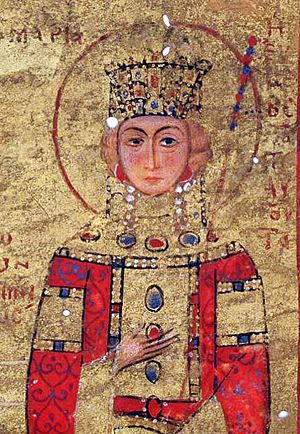Maria of Antioch facts for kids
Quick facts for kids Maria of Antioch |
|
|---|---|

Manuscript miniature of Empress Maria (Vatican Library)
|
|
| Byzantine Empress consort | |
| Tenure | 24 December 1161 - 24 September 1180 |
| Born | 1145 Antioch (now Antakya, Hatay, Turkey) |
| Died | 1182 (aged 36–37) |
| Spouse | Manuel I Komnenos |
| Issue | Alexios II Komnenos |
| House | House of Poitiers |
| Father | Raymond of Poitiers |
| Mother | Constance of Antioch |
Maria of Antioch (born 1145, died 1182) was a powerful Byzantine empress. She became empress by marrying Manuel I Komnenos, who was the Byzantine Emperor. After her husband died, she also served as a regent for their young son, Alexios II Komnenos. She ruled for him from 1180 until 1182.
Contents
Early Life and Royal Marriage
Maria of Antioch was born in 1145. Her parents were Constance of Antioch and Raymond of Poitiers. Her family was important in the Crusader states, which were Christian kingdoms in the Middle East.
A Princess from Antioch
In 1160, Maria's stepfather, Raynald of Châtillon, was captured. This caused problems for her mother, Constance, who wanted to rule the Principality of Antioch. However, the nobles supported Maria's brother, Bohemund III of Antioch.
King Baldwin III of Jerusalem made Bohemund III the prince. He also appointed a regent named Aimery of Limoges. Constance was not happy with this decision. She went to Constantinople to complain to Emperor Manuel I Komnenos. The emperor was the official ruler over Antioch.
Choosing an Empress
Emperor Manuel I Komnenos's first wife had died. He wanted to marry a princess from one of the Crusader states. Two princesses were considered: Maria of Antioch and Melisende of Tripoli. Both were known for their beauty.
According to historical writings, Maria was the more beautiful of the two. She was tall and had blonde hair, showing her Norman family background. Even though King Baldwin III suggested Melisende, Manuel chose Maria.
In September 1161, Maria sailed from Antioch to Constantinople. Her wedding took place on December 24 in the famous Hagia Sophia church. Three important church leaders performed the ceremony. The city celebrated with feasts, gifts, and chariot races. This marriage helped strengthen the connection between Antioch and the Byzantine Empire.
Maria was admired for her beauty. One historian described her as being like the goddesses of ancient stories. For several years, Maria did not have children. But in 1169, she gave birth to a son, who would become Emperor Alexios II Komnenos. Maria also took part in the political life of Constantinople. She even helped expose a court interpreter who was cheating Western merchants.
Regent and Downfall
After Emperor Manuel died in 1180, Maria became a nun, taking the name "Xene." However, she still acted as the regent for her young son, Alexios II. A regent is someone who rules for a child who is too young to govern.
Challenges to Her Rule
Even though she was a nun, Maria had many people who wanted to marry her. She chose a man named Alexios, who was Manuel's nephew, as her main advisor. This caused a scandal among the Greek people.
Maria was from the West and favored Italian merchants. Many Greeks did not like her rule, thinking she was not good at it. Her stepdaughter, Maria Komnene, and her husband, Renier of Montferrat, led the opposition. They were also from the West, but they opposed Maria. Maria Komnene was almost as old as her stepmother and might have felt she should be the ruler.
The opposition gained support from the church leader, Patriarch Theodosius I. They used the Hagia Sophia church as their meeting place. Alexios, Maria's advisor, had the patriarch arrested. This led to fighting in the streets of Constantinople.
Tragic End
Manuel's cousin, Andronikos I Komnenos, had been sent away during Manuel's rule. Maria Komnene invited him back. In 1182, Andronikos marched into Constantinople. He encouraged the citizens to attack the Latin (Western European) people living there, especially merchants.
After taking control of the city, Andronikos had Maria Komnene and Renier poisoned. Then, he had Empress Maria arrested. She was put in a monastery or a nearby prison. The empress tried to get help from her brother-in-law, King Béla III of Hungary, but it was too late.
Andronikos forced Alexios II to sign an order for his mother's execution. However, the people ordered to kill her refused. Instead, Maria was killed by two officials and buried in an unmarked grave on a nearby beach.
Andronikos then made himself co-emperor. Soon after, Alexios II was also murdered, and Andronikos took full control of the empire. Later, Andronikos destroyed or damaged most pictures of Maria in Constantinople.
Sources
- Lynda Garland, Byzantine Empresses: Woman and Power in Byzantium, AD 527-1204. Routledge, 1999.
- Steven Runciman, A History of the Crusades, Vol. II: The Kingdom of Jerusalem. Cambridge University Press, 1952.
- Warren Treadgold, A History of the Byzantine State and Society. Stanford University Press, 1997.
- O City of Byzantium, Annals of Niketas Choniatēs, trans. Harry J. Magoulias. Wayne State University Press, 1984.
- John Cinnamus, Deeds of John and Manuel Comnenus, trans. Charles M. Brand. Columbia University Press, 1976.
- William of Tyre, A History of Deeds Done Beyond the Sea, trans. E. A. Babcock and A. C. Krey. Columbia University Press, 1943.
|
Maria of Antioch
Ramnulfids
Born: 1145 Died: 1182 |
||
| Royal titles | ||
|---|---|---|
| Preceded by Bertha of Sulzbach |
Byzantine Empress consort 1161–1180 |
Succeeded by Agnes of France |
See also
 In Spanish: María de Antioquía para niños
In Spanish: María de Antioquía para niños

